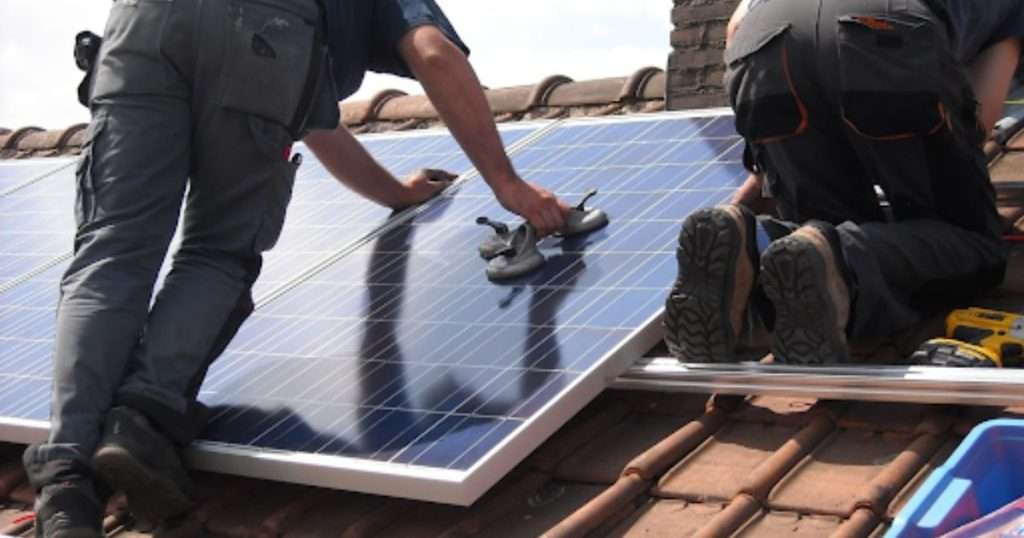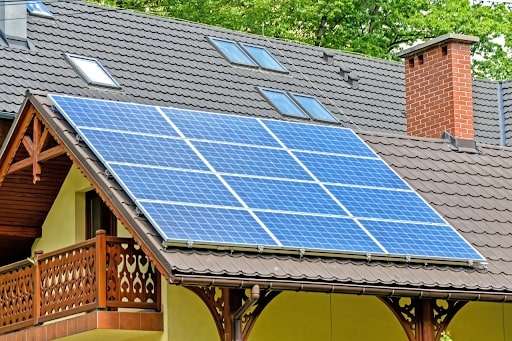Table of Contents
Do solar panels have to be on the roof? dominating renewable energy discussions. Solar panels normally sit neatly on roofs, soaking up the light. The popular image properly represents solar panel installation. They aren’t only for rooftops. Solar energy innovation offers practical and eco-friendly deployment options. The panels are location-independent. Their flexibility lets them catch solar energy in varied settings. Solar energy is expanding rapidly due to a common commitment to sustainability and an increasing understanding of sustainable power generation. With this understanding, photovoltaic panels can go beyond rooftops. Solar technology innovation and adaptation allow us to use solar power in different ways. We want to show solar energy’s potential by investigating these placement choices. Placement matters for households and corporations wanting to reduce energy expenditures and increase sustainability. Let us explain solar panel placement beyond the roof so you can make informed, eco-friendly choices. The question “Do solar panels have to be on the roof?” illuminates solar panel positioning options and their benefits.
Do solar panels have to be on the roof?
Home rooftop photovoltaic panels have long symbolized solar energy adoption. These systems are popular for several reasons. They optimize sun exposure first. Rooftop panels capture sunlight all day, boosting energy output. This is critical for homes seeking the maximum solar ROI. Rooftop installations save room. They on a roof maximizes an unused area. This is important in urban areas with limited ground-mounted system land. Rooftop solar is viable in such environments, many times for cooperatives seeking a solar co-op solution.
Rooftop photovoltaic panels look good too. These inconspicuous installations please homeowners. They fit the house’s decor, making them beautiful. Solar-equipped homes might appreciate due to its modern, eco-friendly, and energy-efficient design. Owners contemplating rooftop solar collectors must consider roof orientation and shadowing. Unobstructed south-facing roofs get the most sun. East and west-facing roofs work but produce less energy. North-facing rooftops get the least direct sunlight, making the panels undesirable.
Ground mounted solar panels
If you have space, ground-mounted solar cells are a possibility. Landowners should install them to enhance energy output. The fundamental benefit of ground-mounted devices is versatility. Ground-mounted solar panel tracking systems track the sun all day. These technologies position panels for optimal sunlight collection. Energy generation exceeds rooftop systems.
Maintenance accessibility is another benefit. Cleaning and maintaining ground-mounted panels is simple. Nobody must climb the roof or handle sharp angles. It reduces panel maintenance expenses and hassle. Another benefit of ground-mounted photovoltaic cells is installation flexibility. Roof orientation and shading don’t limit these systems. Carefully situating them in sunny areas may enhance energy production. Ground-mounted panels’ flexibility makes them perfect for homes with uneven roofs or topography.

Solar canopies and carports
Innovative solar canopies and carports shade and generate clean power. Homes and companies like these buildings because they accomplish two things. Many factors make solar canopies and carports desirable. Their shade and shelter are key advantages. These structures shield cars and provide shade. Climate-friendly solar canopies and carports provide comfort and protection.
Carports and solar canopies boost property value. These installations increase property value. They provide renewable energy and are beneficial. They can increase property value, helping sellers and refinancers. Space matters for solar canopies and carports. These installations optimize parking lot and outdoor recreation space. Many property types benefit from their energy, shade, and shelter.
Solar panels on walls as opposed to roof
Wall-mounted solar panels are rare yet appealing. These technologies are perfect for architects that want to easily incorporate solar. Architectural integration is wall-mounted photovoltaic cells’ principal value. The building can use these panels as power generators and architectural elements. This technology helps homes and businesses use renewable energy without changing their look.
Vertical sun is also good. Urban locations with limited horizontal space benefit from wall-mounted panels that collect sunlight from different directions. In compact locations, this flexibility in capturing sunlight optimizes energy generation. Wall-mounted panels are nice. Installations may be lovely and useful. They may provide clean power and be unique art, appealing to eco-conscious and creative people.
Floating solar panels
Renewable energy innovations are floating photovoltaic panels. Ponds, lakes, and reservoirs sustain these panels instead of land or buildings. This location provides several benefits. A major benefit of floating photovoltaic cells is reducing water evaporation. These panels cover water surfaces to reduce evaporation. It impacts water conservation, especially in water-scarce areas.
Optimization of space is another benefit. Water-based floating solar cells free up land. Land is important in densely populated areas. Aquatic panels save land for agriculture, entertainment, etc. Water cooling under panels is another feature. Water cools photovoltaic cells, which lose efficiency when heated. Cooling improves solar power system efficiency and energy production.
Remote solar panels
Ground-mounted photovoltaic panels are common in remote areas with little infrastructure. They can withstand remote locations and provide electricity when grid access is limited. This location offers advantages. Photovoltaic cells may generate power off-grid. They offer self-sustaining power in remote places where grid connection is impractical or expensive. They power remote homes, farms, and other applications that demand reliable electricity.
Also crucial is cost-efficiency. Off-grid photovoltaic cells save money on grid infrastructure. This can save a lot in locations where grid expansion is too expensive. Off-grid solar cells are economical and efficient, making them suited for remote areas. Sustainability is crucial for off-grid solar. These solar-powered systems reduce remote development’s environmental impact. Reduce greenhouse gas emissions, prevent climate change, and promote sustainability and environmental responsibility.
Industrial and commercial solar panels
Many commercial and industrial buildings have photovoltaic cells. Offices, warehouses, and factories install sunlight collector panels. Large roofs make these buildings solar-friendly. Ground-mounted systems are common in large structures with land. These serve commercial and industrial facilities. These installations reduce operational costs. Businesses may cut energy usage and sell extra into the grid. Energy cost reductions boost business earnings.
Sustainable commercial and industrial solar panel installations are another benefit. Businesses that use sustainable energy are environmentally responsible. This might improve their image and attract green customers. Commercial and industrial photovoltaic panels boost image. Solar-powered enterprises are innovative, eco-friendly, and responsible. Good image may promote a company’s brand and attract green customers and partners.
Dual sided solar panels
Bifacial solar panels are promising. These panels are efficient because they collect sunlight from all sides. Wall, rooftop, or ground mounting options exist. Bifacial solar cells boost energy production. By capturing sunlight from both sides, these panels generate more electricity than monofacial panels. This increases energy yields, making them cheaper.
Another benefit of bifacial panels is adaptability. Homeowners and businesses may choose the best location. Bifacial panels are useful for ground-mounted tracking systems since they capture energy on both sides. Light-reflected areas benefit from bifacial panels. This includes snowy, sandy, or reflective conditions. The panels can create electricity from light bouncing off these surfaces. Perfect for snowy places, bifacial panels generate power from direct and reflected sunlight.

Solar farms
Solar farms with 1,000 panels are massive. Most of these facilities provide significant grid electricity. Solar farms have large expanses and lots of sun. Solar farms greatly cut greenhouse gas emissions. These facilities replace fossil fuels with renewable energy. They reduced carbon emissions, reducing climate change.
Solar farms increase power, another benefit. These plants produce lots of power. This satisfies expanding renewable energy demand and delivers surplus electricity to the grid, enhancing energy availability and reliability in cities and regions. Solar farms benefit local economies. Construction, maintenance, and operation of these facilities create local jobs. Solar farms strengthen local economies and create jobs.
Solar panels on residences
Residential solar panel utilization rises. Solar power decreases energy costs and benefits the environment, therefore more houses use it. Rooftop installations remain popular, but new placements are emerging. Household solar cells save energy significantly. Power generation may drastically reduce household energy costs. Cost savings over time strengthen household finances.
Environmental concern drives residential solar panel adoption. By employing solar energy, homeowners reduce their carbon footprint, greenhouse gas emissions, and environmental effect. Many eco-friendly families share these values. Key benefits include energy independence. Photovoltaic cells on homes provide energy security. Solar cells and energy storage systems run essential appliances and keep households comfortable during power outages.
Solar panels and sustainability
Sustainable solar panel deployment requires adaptation. Solar power reduces climate change and greenhouse gas emissions. Solar panel placement may reduce carbon emissions and preserve the planet for individuals, businesses, and communities. They reduce greenhouse gas emissions, improving sustainability. Sunlight emits no direct emissions, unlike fossil fuels. Clean energy may mitigate climate change for businesses and individuals.
Another benefit is air pollution reduction. Clean, green solar energy. They can improve air quality, public health, and resident well-being. Energy diversity is essential for sustainability. Also, they may boost energy security and reduce fossil fuel consumption. Diversification makes energy supply more robust to price volatility and supply outages.
Future solar panel placement
As technology progresses, solar panel placement will become more imaginative. Engineers are studying solar roads and windows, which might revolutionize electricity generation and usage. These advances might make solar power part of our built environment. Solar-integrated building materials are intriguing in solar panel deployment. Researchers install photovoltaic panels on windows, rooftops, and facades. This discovery might alter energy generation and building design, making solar electricity standard.
Smart photovoltaic cells are another invention. Advanced technology can boost these panels’ efficiency and utility. These may detect, monitor weather, and store energy to optimum production and consumption. Solar roads interest me. Researchers are exploring roadside solar cells. These “solar roads” may employ LED lights for road markers and signage and generate solar electricity. Solar roadways might power electric vehicles and improve road safety.
Conclusion
Finally, in answer to the question, do solar panels have to be on the roof? We have come to know that photovoltaic cells move beyond rooftops. Ground-mounted systems, solar canopies, wall-mounted panels, and floating solar installations are available. Each location offers energy generation, architectural integration, financial savings, and environmental responsibility. These panels promote green energy. They will have more interesting placement possibilities in our built environment and daily life. These innovative solutions may help individuals, businesses, co-ops investing in solar and communities go greener.
